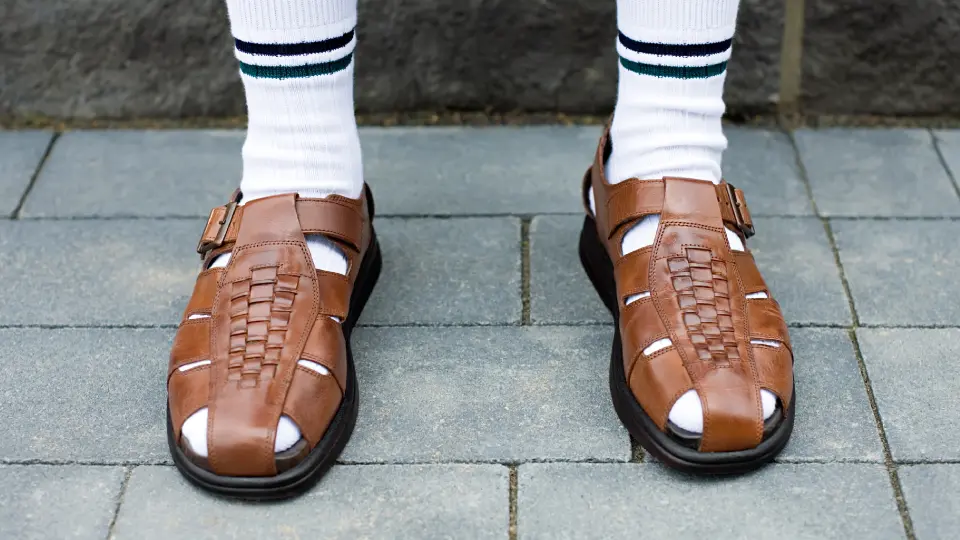How To Stretch Leather Sandals: 6 Creative & Effective Methods
Purchasing the perfect sandal size is highly recommended since incorrectly sized sandals can cause foot pain, biochemical imbalance, and even induce falls, especially when worn over a long period.
Leather sandals are typically made of soft and malleable leather that can mold to the shape of your feet after use. However, if you want the leather sandals to fit your feet perfectly and they feel a little too small or tight, you should stretch them.
Stretching leather sandals is part of the “breaking-in” process of leather sandals since new sandals are typically snug on your feet. Check out our complete guide on how to break in leather sandals, where we share more useful tips.
If your leather sandals are too tight for comfort, this guide will help you! In the following sections, we’ll teach you how to stretch your leather sandals safely without affecting their original texture or shape.
The following methods have been tested by us and they work when they are correctly executed. The best way to stretch leather sandals is to condition them, wear them regularly, use a sandal stretcher or a stretching spray, stuff newspaper into them, and use heat to stretch them.
1. Conditioning Leather Sandals
Conditioning leather sandals will make them more soft and supple, allowing them to mold to your feet’s shape much more easily. Applying a conditioning layer can also help increase its durability and restore its color and appearance.
The natural oils of the conditioner relax the leather fibers and renourish them with all of the essential oils. This makes your leather sandals feel more flexible, while also adding a protective layer.
How To Use Conditioners to Stretch Leather Sandals
Using a leather conditioner is straightforward. Simply apply a quality leather conditioner on a soft, lint-free cloth and rub it onto the leather straps and the leather footbed using gentle pressure.
Ensure to target the area where the seams of the straps and the soles meet. After the conditioner has dried, buff out any excess conditioner for a glossy finish. Simple wear your leather sandals regularly or use any method below for an increased effect.
2. Wearing Your Leather Sandals
Another great way to stretch your leather sandals is to wear them. You can also wear thick socks beneath your sandals and flex your feet to stretch them more easily and quickly at home.
This stretching method works best after conditioning your leather sandals since it makes them more malleable. Leather is a natural material that will adapt to the shape of your feet.
How to Stretch Your Leather Sandals By Wearing Them
You can begin wearing your leather sandals for a short time as you run errands or take a quick walk. Wearing them for a small amount of time will help stretch the leather sandals without causing any blisters on your feet.
When your feet begin to hurt, it is best to take the leather sandals off and repeat the process the next day. This may take a couple of days but you’ll quickly notice them feeling more comfortable over time.
If you feel that your leather sandals are too tight and that they aren’t stretching enough, remember to use a leather conditioner beforehand to soften the fibers.
3. Using a Sandal Stretcher
A sandal stretcher or a shoe stretcher can be used to stretch out leather sandals with ease. We recommend going for the FootFitter Premium Professional Stretcher or anything similar since it works great for leather sandals.
How to Use a Sandal Stretcher to Stretch Leather Sandals
You can use the two-way stretching feature to stretch out the sandal straps and the upper of your leather sandals. To stretch the sandal straps, place the stretcher inside the leather sandal and turn the widening handle clockwise until tight against the straps.
To adjust the height and to stretch the sandal’s upper, you can adjust the lengthening wheel counterclockwise until it is tight against your leather sandals. Leave the sandals with a shoe stretcher inside for 6 to 8 hours for optimum results.
Moreover, this sandal stretcher is made of beech tree wood that can absorb excess moisture from your sandals and protect them from mold.
4. Using a Stretching Spray
A leather stretching spray allows you to loosen the fibers of your leather sandals and soften them to become malleable. Although leather also stretches when it is wet, this solution ensures your leather material stretches without damaging the leather texture.
After many trials, we found FootMatters Professional Boot & Shoe Stretch Spray to be one of the best stretching sprays for leather sandals. The reason why it’s great is that it’s designed to work on various leather types such as top-grain and even nubuck or suede.
How to Use Stretching Spray To Stretch Leather Sandals
To use a leather stretching spray, you need to shake it and spray it generously on the tighter areas of your leather sandals. Ensure to target the inside and outside of your leather sandals for best results.
After application, you need to wear your leather sandals with the thickest socks until the leather dries. Wearing thick socks underneath your leather sandals will stretch them to adapt quickly to your foot’s shape.
Additionally, you can also opt for placing a wooden sandal stretcher in your sandals overnight after application. If you don’t have a stretcher handy, you can stuff your leather sandals with newspaper and leave them overnight.
5. Stuffing Newspaper into Leather Sandals
Stuffing your leather sandals with newspaper is an affordable and easy way of stretching them. This method relaxes the upper part of leather sandals and applies just enough pressure needed to stretch them out.
However, this method isn’t very effective for leather straps. Therefore, we only recommend using this method if you’re targeting the sandal’s upper.
How to Use Newspaper to Stretch Leather Sandals
Start by crumpling up some newspaper into balls and lightly spraying them or blot them with water with a paper towel. Place them inside the leather sandal and shape them according to the areas you want to stretch and push out.
You should leave the newspaper inside the leather sandals for a couple of hours. We suggest just leaving them overnight. Be cautious that the newspaper isn’t dripping wet but only damp to the touch since excess water can damage leather.
6. Heat Leather Sandals
You can also use a hairdryer to stretch your leather sandals in specific areas. This method is only recommended for spot-stretching (stretching targeted areas of your sandals) since excessive heat can harm the leather texture.
How to Use Heat to Stretch Leather Sandals
Wear your leather sandals with thick protective socks. Put your hairdryer settings on medium and apply warm air to areas that you wish to stretch. Try flexing your feet when applying heat to create a bulge on the upper – this will cause it to stretch.
After heating all the spots that need to be stretched, continue wearing the sandals and flex your feet until they have cooled down. Be careful to heat the sandals only 30 seconds at a time and use a leather conditioner afterward to avoid drying out the leather.
Important Things to Look Out for When Stretching Leather Sandals
This guide has provided several creative methods for stretching your leather sandals. However, there are certain things that you should take note of when following the process.
Below you’ll find best practices for stretching leather sandals so that they fit your feet perfectly. Remember to keep them in mind when applying any of the methods that we shared above.
- Only Use Leather-Friendly Products – Leather is a sensitive material that can discolor or harden when using harsh chemicals. Using leather-friendly products ensures the stretching of leather sandals without any ill effects. Therefore, read product descriptions carefully.
- Be Careful When Stretching Leather Sandals – Leather sandals straps can break if you apply too much force or pressure while stretching them. This is because leather straps are thin in design. Therefore, you should be careful about the components while stretching the sandals.
- Allow Some Time for Stretching – If you are unsure how much stretch or give you want in your sandals, stretch them little by little over time to prevent overstretching. Overstretching can cause damage to the leather’s fiber structure.
- Select Your Methods Carefully – Always choose safe stretching methods, products, and materials that will suit the shape and type of your leather sandals.
Frequently Asked Questions
Let’s take a look at some of the most frequently asked questions on this topic. Some of them were sent in by our readers, so feel free to reach out to us, if you would like to have yours added.
How Often Should I Stretch Leather Sandals?
Stretch your leather sandals as and when you need to. While we suggest buying correctly-sized sandals from the get-go, feet and leather sandals can grow and shrink.
When you notice that your leather sandals are a little too tight and are compromising your comfort, we suggest stretching them using any of the convenient methods that we listed above.
What Method is the Stretching Best?
We found that the most effective method is stretching them naturally by wearing them, after having used a leather conditioner or spray The reason why we prefer stretching by wearing them is that they adapt to the shape of your feet, while a leather conditioner or spray softens the leather.
Can I Use Multiple Methods?
Yes, you certainly can. Choose a method that is best suitable to your preference and that requires the products and tools which are available to you. Feel free to use a combination of stretching methods, too.
However, just keep in mind to stretch your leather sandals gradually. The stretching process may take time and also keep in mind not to practice overstretching to avoid damage.

About Gerrit
Co-Founder, Researcher & Writer At Leatherskill
I’m a leather enthusiast who spends most of his free time crafting, researching, and writing about the many facets of this versatile material. Thanks for reading!

